our expertise
To unleash the potential of geo-resources for the prosperity of territories.
Geothermal energies
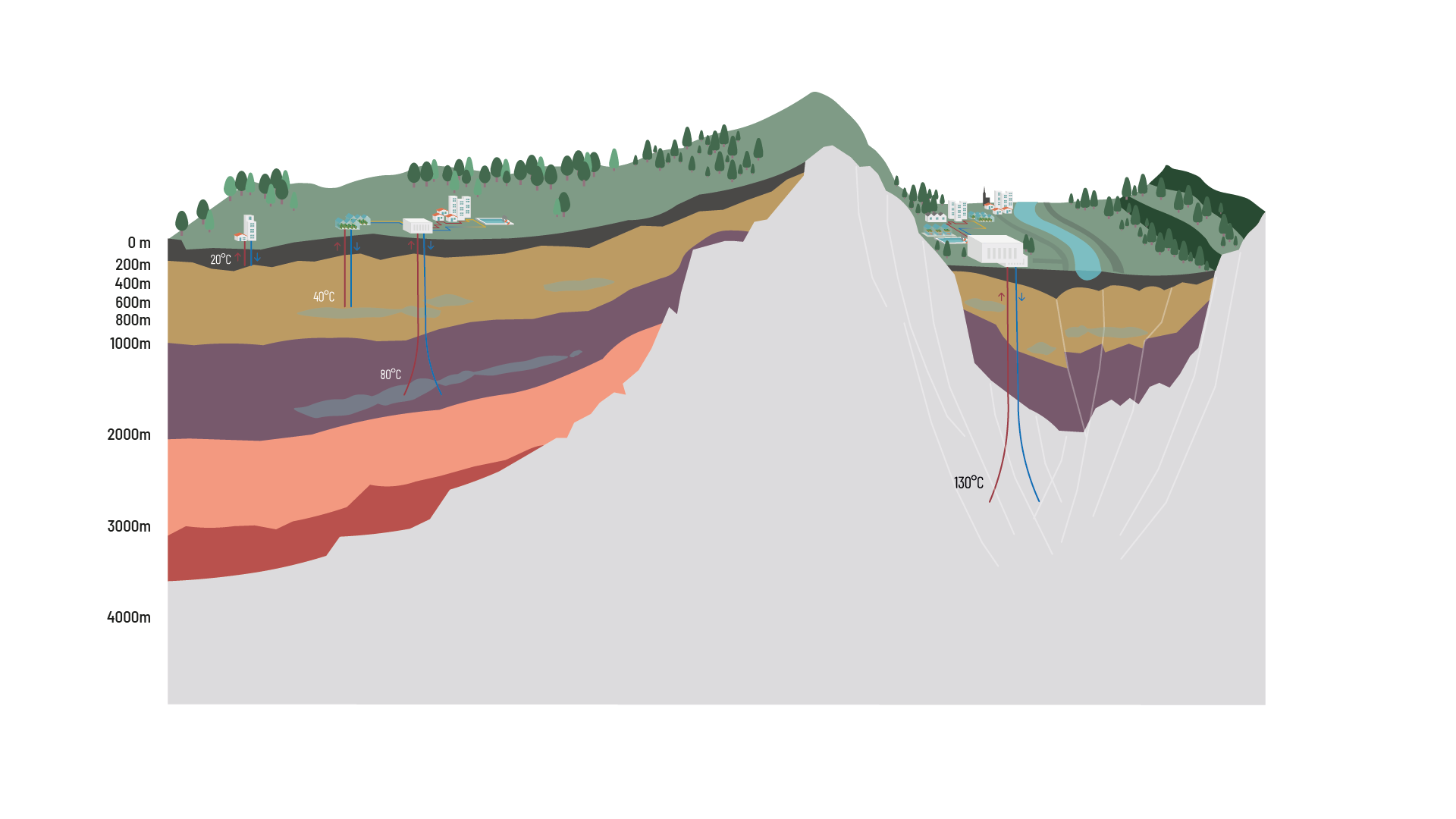
Géothermie de surface
Shallow geothermal energy - between 0 et 200 meters deep - can be used in over 90% of France - temperature of geothermal water between 12°C and 18°C
Géothermie profonde
Geothermal water comes from aquifer reservoirs located at depths of up to 3000 meters - hot water is collected at between 30°C and 90°C.
Deep geothermal energy with lithium
Dependind on the geology, and particularly in the Rhine Graben, geothermal water collected at 3000 meters deep, contains lithium that Arverne Group calls "Geolithium".
Shallow geothermal energy
Surface geothermal energy can be used in over 90% of France. Geothermal probes, installed at depths of up to 200 meters, recover heat from the earth, whose temperature generally varies between 12°C and 18°C. Connected to a heat pump, they generate heat, cooling and domestic hot water…
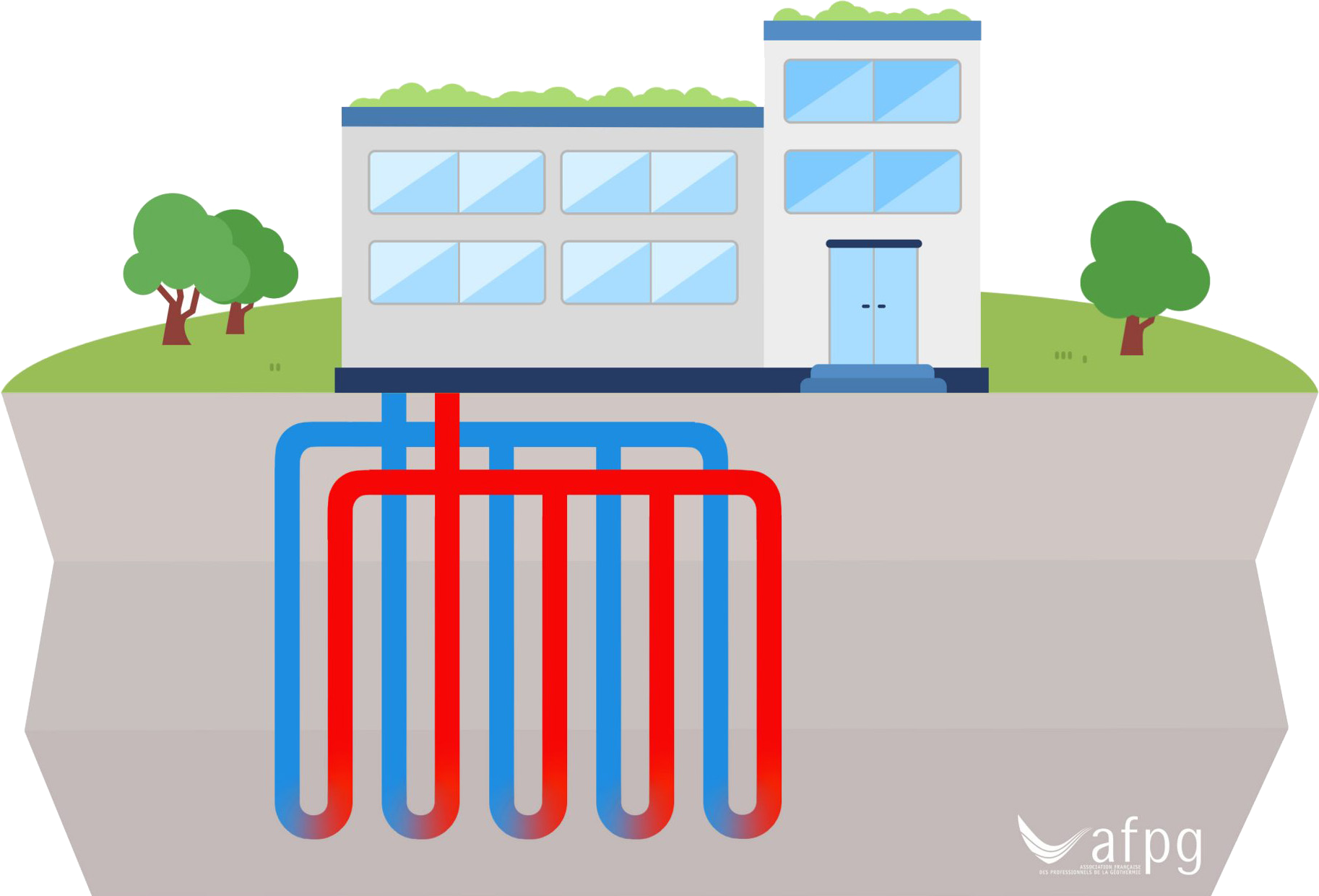
Deep geothermal energy
Geothermal water comes from aquifer reservoirs located at depths of up to 3,000 meters. Thanks to a geothermal doublet, a producer well collects hot water at between 30°C and 90°C. This geothermal water feeds a heating network, then returns underground via the injector well. The circuit is thus closed, and the water is able to heat up again, enabling the doublet to be used over a very long period.
Heat networks can supply municipalities, industries or agricultural estates.
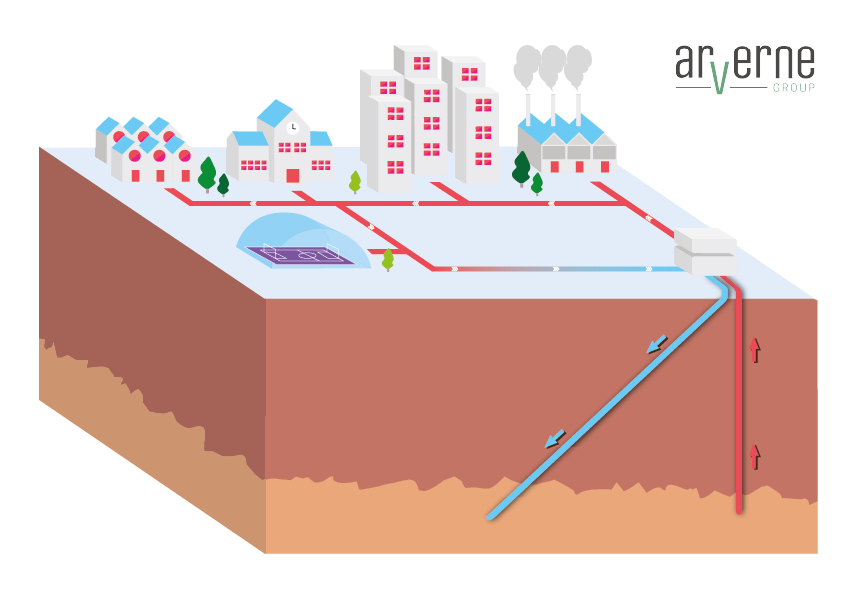
Deep geothermal energy with lithium
Depending on the geology, and particularly in the Rhine Graben, geothermal water contains lithium, an alkali metal essential for electric mobility. Thanks to a Direct Lithium Extraction (DLE) system connected directly to the geothermal power plant, the lithium is filtered using an environmentally-friendly process, since the water is then discharged underground.
Once refined, lithium can be used to build batteries for electric vehicles. Lithium de France in Alsace has chosen to develop technologies to produce lithium carbonate.
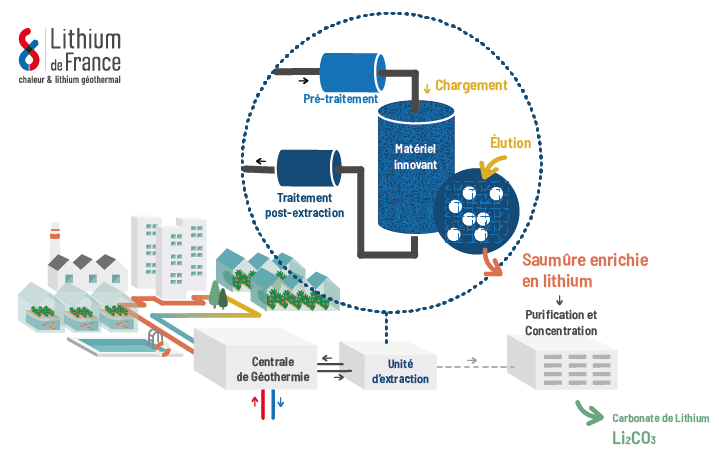
Groupe Arverne develops geothermal projects to produce heat and cooling.
There is deep geothermal energy to generate electricity, which is not part of our business model.
Drilling
A strategic tool
Having a modern, integrated drilling tool means we can guarantee rig availability and secure the schedule of our drilling operations.
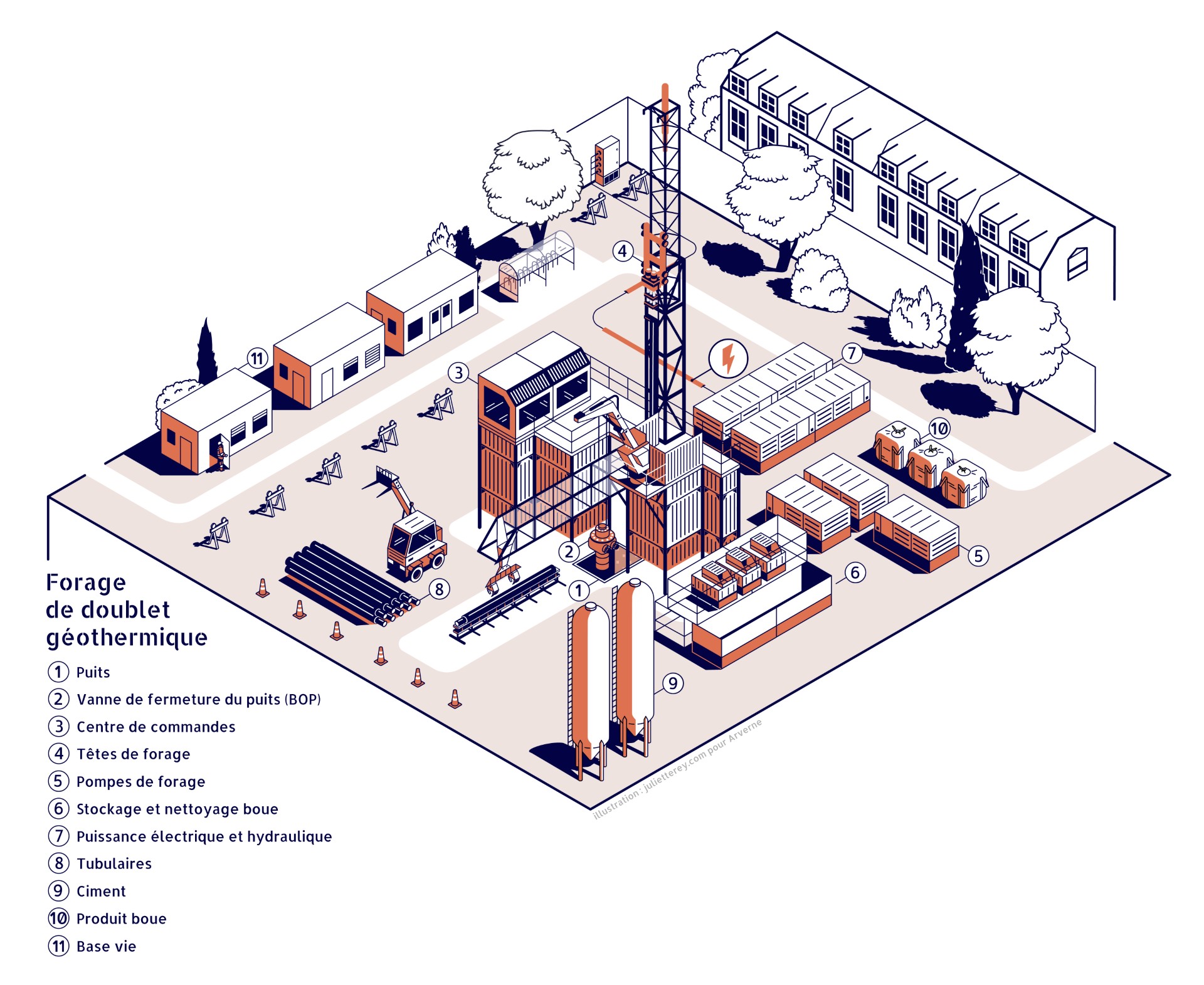
Ciment
Entre chaque phase de forage, le puits doit être stabilisé à l'aide de tuyaux en acier (casing). L'espace entre le tubage et le trou est ensuite rempli de coulis de ciment. C'est ce qu'on appelle la cimentation.
Poste de commandes
C'est de là que sont menées toutes les opérations de forage : le bras de levage pour les tiges, la manipualtion de la tête de forage, les opérations de sécurité...
Traitement des boues
Des boues sont injectées dans le sous-sol avec les différentes tiges. Elles permettent de refroidir le trépan et de faciliter le forage.
Lorsque le forage progresse, des déblais sont remontés. Ils sont triés grâce à des tamis vibrants.
Base vie
Un chantier de forage dure plusieurs mois et est 24h/24. Les équipes ont donc besoin d'espaces pour prendre un repas, faire une pause. Des bureaux de travail sont également nécessaires.
Une base vie permet ainsi au personnel de chantier de réaliser cela.
Tubulaires
Il existe différentes sortes de tiges : celles qui permettent de forer grâce à leur poids, celles qui permettent la construction du puits, celles qui renforcent le puits (casing).
Toutes ces tiges sont levées grâce au mat et sont concentriques (elles sont plus larges à l'entrée du puits qu'en profondeur).
Rotary drilling aims to access deep geothermal reservoirs and bring up hot water to supply heating networks with sustainable, local thermal energy.
How are drilling operations carried out?
Preliminary studies
Geological survey and well planning.
Site preparation and preparation of the land for the rig, which is then assembled.
Dismantling Transport Assembly (DTM)
Drilling rigs are complexes of mobile equipment that can be moved from one drilling site to another, drilling a series of wells.
These operations require considerable logistical coordination and take several weeks to complete.
Drilling with rods and bit
The rock is drilled using a cutting tool called a drill bit. Drill rods push the bit down into the subsoil.
Drilling is continuous, with rod sections added as depth increases.
Drilling mud circulation
The spoil produced by the drill bit is transported to the surface using a special slurry.
The spoil is then sorted by vibrating sieves.
Stabilization and cementation
After drilling a certain length of hole (phase), the well must be stabilized using steel pipes (casing) connected by threaded sleeves.
The space between the casing and the hole is then filled with cement grout.
The final depth of the well is obtained by drilling holes of decreasing diameter, successively protected by casings, also of decreasing diameter, producing a structure composed of concentric tubular elements.
Reaching depth and testing
Once the depth has been reached, temperature and pressure checks are carried out to validate the drilling.
Once the borehole has been approved, pumps are installed and connected to the geothermal power plant.
Work on vertical geothermal probe fields is carried out using drilling rigs capable of reaching depths ranging from a few dozen meters to over 250m.
Preliminary studies
Beforehand, a design office determines the size of the probe fields according to the surface area of the building and its energy performance.
Drilling
The driller digs into the ground using rods and a tool about 15cm in diameter. The borehole is then cemented to protect the structure and allow heat recovery.
Several probes are installed, according to the previously defined dimensions. They are generally spaced a few meters apart.
Fitting probes
Probes are inserted into the boreholes. They are then all connected together in a collection chamber, which in turn is connected to the geothermal heat pump.
Commissioning the heat pump
Once the probes have been connected to the geothermal heat pump, the building can be heated, cooled and supplied with domestic hot water thanks to this system. system.
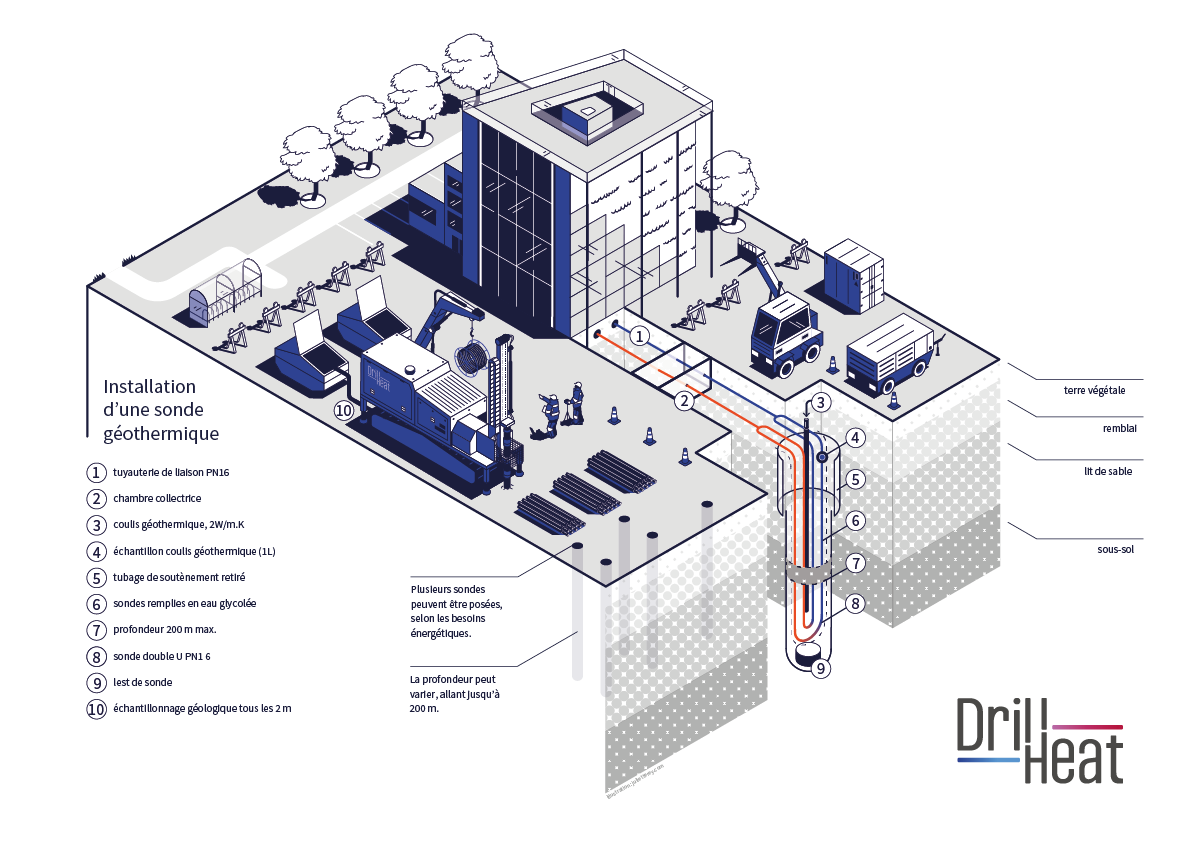
Sonde géothermique
Elle est insérée dans le sol et c'est elle qui remonte les calories du sol à la surface pour chauffer et rafraichir le bâtiment.
Chantier
Sous-sol
Profondeur de la sonde verticale à définir selon le contexte géologique.
